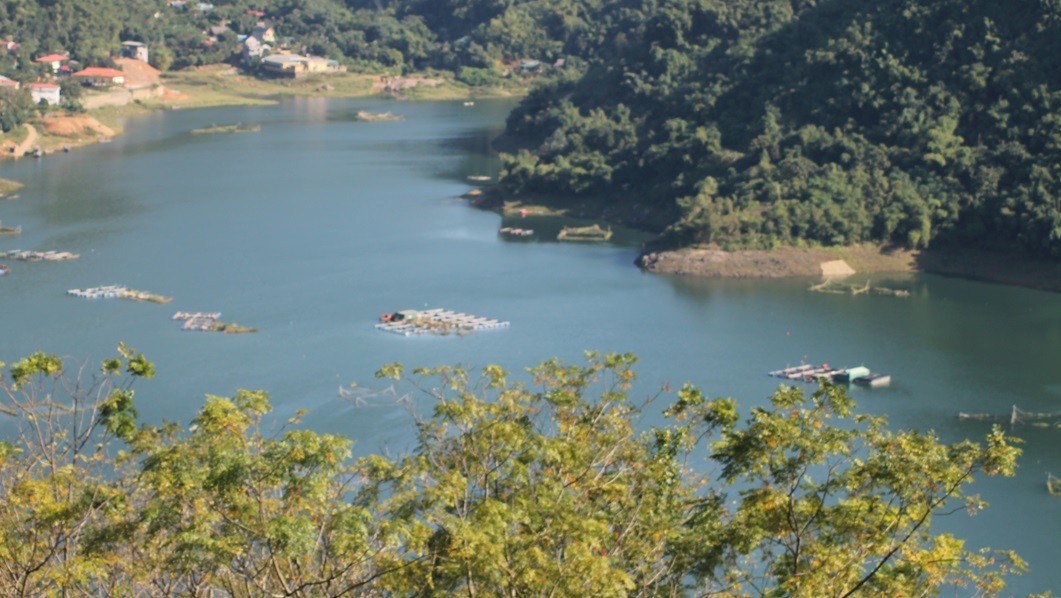
Replication of Community tourism model in Hoa Binh mountainous communes
Latest
 |
| A corner of Hoa Binh lake. (Photo: Hong Hanh) |
Advantages of community tourism
Hoa Binh is one of the provinces where the community tourism model has been inititiated and implemented earliest compared to the northern mountainous provinces. Since the 90s, the community tourism model in Lac hamlet (Chieng Chau commune, Mai Chau district) has been well known to tourists, especially international visitors.
Hoa Binh province currently holds numerous advantages to develop community tourism, especially in mountainous areas and ethnic minority areas. Majestic natural landscape, with beautiful caves and nature reserves are diverse. And the species are various in ecosystems with animals and plants. Hoa Binh Lake has a charming landscape with 47 large and small islands which create a space like Ha Long Bay in the mountains, offerring favorable conditions for Hoa Binh tourism to develop.
The rolling limestone mountainous terrain create many beautiful caves such as: Dragon Head Mountain cave complex (Cao Phong district); Chua Tien cave complex (Lac Thuy district); Ngoi Hoa cave, Nam Son (Tan Lac district); Trung Son cave (Luong Son district)... Primary tropical forests such as: Pu Canh Nature Reserve, Da Bac district; Ngoc Son - Ngo Luong nature reserve, Tan Lac and Lac Son districts; Thuong Tien Nature Reserve, Kim Boi District; Pa Co - Hang Kia nature reserve, and Mai Chau district.
In addition to rich natural resources, Hoa Binh also has humanistic tourism resources imbued with the cultural identities of the Muong, Kinh, Thai, Tay, Dao and Mong ethnic groups with abundant diverse humanistic values. This place has the famous prehistoric culture "Hoa Binh Culture" (Hoabinhian), considered the cradle of Viet-Muong culture as the homeland of the epic "Giving Earth, Giving Water".
Hoa Binh currently has 41 relics ranked at the National value level and 53 relics at the Provincial value level; with many ethnic folk festivals still being preserved and promoted, typically: Muong Bi Khai Ha Festival (Tan Lac district); Bo Temple Fiesta (Cao Phong and Da Bac districts); Fairy Pagoda Fiesta (Lac Thuy district); Xen Muong Festival (Mai Chau district) have been an attractive beauty spot for domestic and international tourists from France, America, Australia, Germany, Belgium, Netherlands, England among many others.
Ethnic people have ways to escape poverty
In recent years, community tourism in Hoa Binh province has been considered an important economic sector, community tourism destinations have increasingly received the attention, support and development through projects as a result of supportive central and provincial policies.
Thanks to taking indigenous culture as the root, community tourism has developed strongly in Hoa Binh and spread to neighboring localities, demonstrated with increasing number of domestic and foreign tourists coming to Hoa Binh.
According to a report from the Department of Culture, Sports and Tourism of Hoa Binh province, in the first 6 months of 2023, the whole province welcomed 2.36 million visitors and tourists, an increase of 28.8% over the same period last year, reaching 67.4% of the year plan, including 240,000 international visitors and 2,120,000 domestic visitors.
Total revenue from tourists reached VND 2,300 billion, an increase of 16.2% over the same period last year, reaching 59% of the year plan. In particular, the contribution of community tourism is not small. Community tourism has been creating sustainable livelihoods, facilitating the ethnic minorities and mountainous people in Hoa Binh province to escape poverty and to become rich.
 |
| The Dao ethnic women in Sung hamlet, Cao Son commune, Da Bac district, Hoa Binh province are knitting their brocade skirts. (Photo: Hong Hanh) |
Although community tourism in Hoa Binh has attracted many visitors in recent times, community tourism development has encountered a number of obstacles and challenges and revealed certain shortcomings and limitations that need to be overcome.
It is to notice that the road system connecting villages, hamlets, and community tourism destinations are still in poor condition and lacking in uniformity; the clean water supply systems, waste and wastewater treatment areas have not been properly attended and/or maintained with investment; low quality telecommunications infrastructure does not meet the service demands of tourists; tourism products are meager, monotonous, and of low quality; the quantity and quality of human resources are poorly qualified both in shortage of manpower and weakness in terms of professional expertise, especially the tour guide team at community tourism destinations; tourism promotion activities have not been adequately attended, showing no well-built brand or tourism image with its own characteristics; the industry linkages between tourism, agriculture and countryside areas to form product value chains are still limited while others are not highly effective.
To develop community tourism commensurate with its potential and strengths, Mr. Nguyen Van Toan, Vice Chairman of the Provincial People's Committee, Head of the Tourism Steering Committee of Hoa Binh province said: “The People's Committee of Hoa Binh province has issued Decision No. 446/QD-UBND dated March 10, 2020 to approve the Project to develop community tourism associated with building new rural areas in Hoa Binh province until 2030.
Accordingly, by 2030 Hoa Binh province strives to invest in construction of facilities for 290 community tourism households, with capacity to accommodate over 1.65 million tourists; the total revenue from community tourism is targeted to accounts for 19.5% of total revenue from tourism.
The province will also support the replication of the community tourism model for communes in mountainous areas; it is to make investment in upgrading the transport infrastructure for linking the community tourism destinations.













